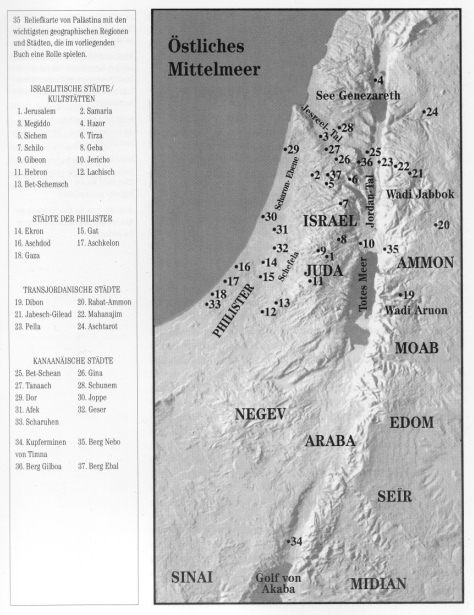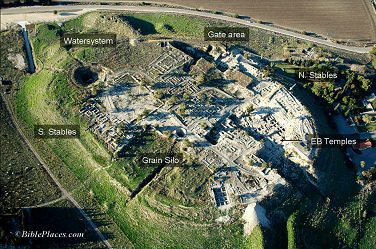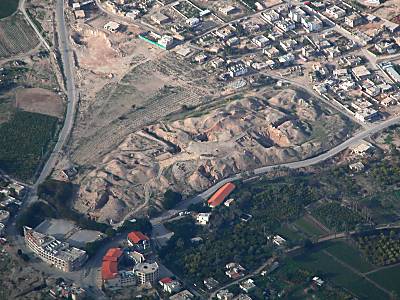from: Israel
Finkelstein / Neil A. Silberman: The Bible
unearthed. Archeology's New Vision of Ancient Israel
and the Origin of Its Sacred Texts; The Free Press, a
division of Simon & Schuster, Inc., 2001; Deutsche
Ausgabe: Verlag C.H.Beck oHG, München 2002;
Here in this analysis is used a
German version "Keine Posaunen vor Jericho" of DTV,
Munich 2004, second edition of 2005. All page
indications refer to the German version. I hope the
page numbers are not very different.
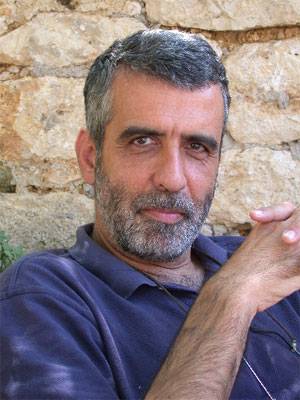
Israel Finkelstein, portrait, Archeology
Department, Tel Aviv
|

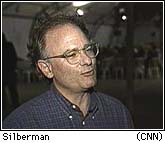
Neil Asher Silberman, portrait
|
Preface
Old Testament has to be
written in an new manner. Some murders, some brave
actions, and some slaveries can be omitted, and other
culprits must be added, above all considering the policy
of Egypt Empire and of the Empires in Mid East.
The presenting work is a survey in a
chronological form of history of Jewry up to
Nebuchadnezzar, always with indications about
disagreements according to documents and archeology.
Many Jews know about it, but most of the Christians
don't know anything.
Christianity even refuses further
education since centuries whereas Bible researcher and
archaeologists are Jews in many cases.
There should change something: We need
a new Old Testament by chief rabbis.
Here was analyzed the German edition
"Keine Posaunen vor Jericho" edited by dtv 2004.
Michael Palomino
April 2006
1. General
information about Bible research, documents and
archeology
There is a scheme of
development for written documents
Strong written documents regularly are made in a strong
state. There are characteristics for a strong state:
-- big houses
-- a specialized economy
-- a dense net of communities with villages up to big
towns (p.34).
So, in a region where are only villages or nomads there is
no great literature, economy or state's administration,
and big houses are missing. When there cannot be found any
remnants for a certain time, so this is an indication that
the population was organized in a nomadic way without any
army (p.34).
Bible research
There are some methods of Bible research
-- by analysis of languages and by analysis of different
kinds of texts with the research of the origin of the
different texts
-- archeology is proving history by remnants found or can
contradict faked legends by remnants - or not found
remnants
-- so a big part of history in Israel-Palestine from 1,000
to 400 before "Christ" can be deduced today.
By all this the texts of the Bible can be classified in a
new way and we can make a difference between poetry and
historic descriptions (p.15).
Documents in Egypt
are correcting the OT: there are letters from Pharaohs
and the Amarna letters
Above all the letters of the Tell al-Amana contain the
correspondence of the pharaohs. These are about 400 Amarna
tablets which are distributed over all the world in
museums today,
-- with letters of the Hittite kings (today Anatolia,
Eastern Turkey) to the Pharaoh
-- with letters of Babylon Empire (today Iraq) to the
Pharaoh
-- and above all with letters from the city states of
Canaan when they were subordinated states, with letters
from Jerusalem, from Sichem Megiddo, Hazor, and Lachish
(p.90).
Archeology in
Israel-Palestine is correcting the OT
-- archeology can state with remnants e.g. which
agriculture in which time was applied, which tradition of
meals were, how was the structure of the town (p.15), who
were the trade partners etc. (p.16)
-- archeology is setting free all locations which are
mentioned in the Bible, and basically can confirm or
disprove the Bible text
-- archeology can make laboratory tests and can
distinguish the civilizations of the Israelis,
Philistines, Phoenicians, Aramaic, Ammonites, Moabites and
Edomites
-- archeology can state inscriptions and seals, and by
this archeology can connect the persons with the bible
texts (p.16)
-- Arab word "et-Tell" and Hebrew word "ai" mean "the
ruin" (p.96).
From the 1940s on archeology developed
new methods of research finding pattern of settlements and
maps of settlements of the past. By this also demographic
developments can be stated (p.122).
Since 1967 complete
archaeological groups (with students) are working in the
newly Jewish occupied territories of the alleged tribes
Judah, Benyamin, Ephraim, and Manasseh, and daily are
investigating a surface of about 2.6 km2.
There are excavations at many locations thinking something
important could be found there (p.122).
By the remnants found in Egypt and by
deciphering of hieroglyphs (p.28) and by findings of
cuneiform scripts in Mesopotamia (p.28,30) history in
Israel Palestine can be researched precisely, independent
of Hebrew Bible. Many and essential lies in Old Testament
can be made out (p.30).
[There are repeating political changes
in the big Empires - but this for example is not mentioned
but is presented as "God's miracle" etc.].
Figures in the Pentateuch
Pentateuch is brilliant indicating
different dates for the same event:
-- leaving Egypt is said having happened
480 years before the construction of the temple in 4th
year of Solomon's lordship (1st Kings, 6,1)
-- it is indicated that the Israelits
had suffered 430 years of slavery in Egypt (Exodus 12,40)
-- Abraham, Isaak and Jakob are said
having reached an age of over 100 years (p.47)
-- but the average life expectation in
these times during the alleged person of Mose was only 40
years (p.64-65).
Comparison
with European epochs
Compare the epochs in Middle East with the European
epochs:
European
data of epochs
|
| Epoch |
date |
Early
Bronze Age
|
3500-2200
B.C. appr. |
Interim
period
|
2200-2000
B.C. |
Middle
Bronze Age
|
2000-1550
B.C. appr. |
Late
Bronze Age
|
1550-1150
B.C. |
Interval
between late Bronze Age and Iron Age I
|
12th
century (p.135) |
| Iron
Age I |
1150-900
B.C. appr. |
| Iron
Age II |
900-586
B.C. |
| (Finkelstein / Silberman:
Posaunen 2001, edition 2004, p.130) |
The strip of Israel Palestine
-- there are many dry times
-- this place is always a place of wars
between the big Empires Egypt and Syria (p.15) because the
leaders want to reign over the trade roads to Africa or to
Arabia (p.289)
-- during Bible times compared with
Egypt and Mesopotamia the strip of Israel Palestine has
only a very little population and culture is very low
(p.15)
-- there can be stated that there was an
old agriculture
-- at the end of European Stone Age the
populations are settling down
-- during the European Bronze Age in
3500 to 1150 B.C. there is developing a town's
civilization (p.32) [above all on the coast line and in
the plains, in the mountains only later]
-- during the
European Iron Age from 1150 to 586 B.C. there are
developing territorial states [and also this development
is later in the mountains] (p.32).
There is
an illiterate tradition in the mountains of Israel Judah
Judah tradition is archaic, and there
has to be considered illiteracy:
-- belief is dominating that houses,
farms and tombs will be inherited by the special Gods and
by the ancestors
-- there are sacrifices on cases in the
village, near family graves in the village (p.261), and on
the open altars on the hills ("heights") (p.261-262)
-- during wars the locations of
sacrifices on the heights are rated as intouchable and
stay intact, and this is well described in OT: "The
heights were not abrogated"
-- God JHWH is one of many Gods of the
old tradition
-- for example there are also adapted
cults from neighbor populations
-- God JHWH is adored in different
kinds, sometimes presented with divine followers
-- archeology finds in Judah's old sites
of settlement 100s of naked figurines of naked fertility
goddesses
-- one inscription on North Eastern
Sinai peninsula in Kuntillet Airud stays in cultural
connection to the North Reich and refers according to
Finkelstein / Silberman to Ashera as the wife of God. Also
a latter inscription from the Judah mountains is speaking
of God and Ashera as a pair of Gods (p.262).
[Ashera is an ugarite / Syrian fertility
goddess, the wife of Creator God "El"].
OT: There
is a mix of traditions in the Middle and Mid East region
There is the belief with sacrificial
cults for Baal
(weather god for rain and fertility), for Ashera (Aramaic
fertility goddess) (p.298-299).
There are Gods, to whom are given
sacrifices on the hills, for example
-- goddess of Sidon Astarte (goddess of
love, fertility and night) (p.299), according to
Finkelstein / Silberman represented with a figurine
normally having both tits in their hands (p.309)
-- there is Moab god Kamos
-- there is Ammonite god Milkom (2d book of
Kings, 23, 10-14) (p.299).
More cults are:
-- there is an astral cult: sun, moon
and stars probably are rated as holy symbols and can often
be seen on seals of Judah before the times of king Joshia
(p.309)
-- there is a cult of heavenly hosts
(p.298-299).
This is a total complex of rites: the
sacrifices on the hills, the inscriptions in stones, and
the Ashera pictures etc. The aim is pleading the divine
powers for fertility and wealth. The neighbor populations
have similar rites (p.261).
Biblical and archaeological information
indicate this mix of cults for gods ("syncretism"). But OT
is propagating a "1 god cult" and is claiming [in a
religious racist manner] that all other religious
orientations would be "atrocities" [without describing the
cults precisely]. So, all cults for Baal, for Astarte, for
the angelic hosts and for the gods of the neighbor
countries are demonized [without giving information to the
reader about what the fact is basically].
It's said that the cults also were
performed in the temple of Jerusalem (p.262), but there is
not one single remnant of the "First Temple" (p.261).
[It's possible that the first temple was
only a big tent].
Astarte: Goddess of
love, fertility and night. Jewish orthodox
philosophy is forbidding Astarte, and so called
"Christianity" is following in the same manner
partly until today...
|
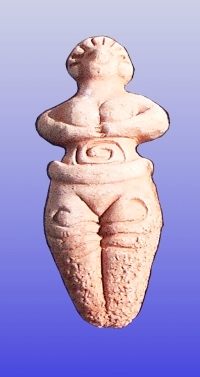
Figurine of Astarte: breasts in their hands 1
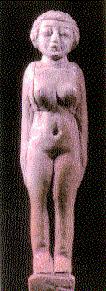
Figurine of Astarte of 8th century B.C., Jewish,
carved ivory, finding place: Gaza strip
|
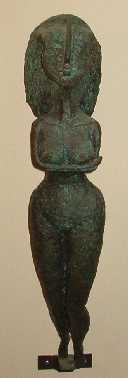
Figurine of Astarte with folded arms before their
tits
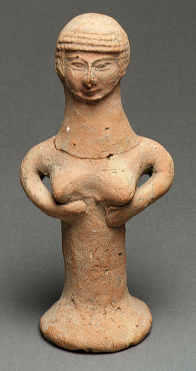
Figurine of Astarte: Breasts in their hands 3,
finding place: Lachish
|
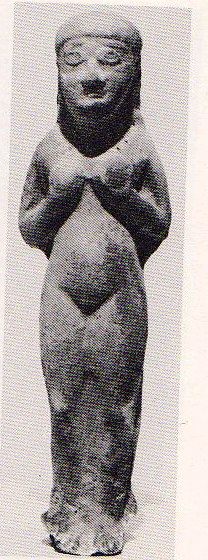
Figurine of Astarte: Breasts in their hands 2
|
Mostly Astarte is presented
with breasts presented in their hands, but also
with simple big breasts.
So,
it seems a basic need having big breasts giving
milk to the baby later, and Israelites have
celebrated also this cult. But this basic need
is always damned in the patriarch population
since the grounding of the North Reich Israel in
7th century B.C. So, the patriarchs have not
recognized life, and "Christianity" is following
this...
|
Cults of Baal
(p.262)
Baal was a god of fertility and of weather, above all a
rain good for the peasants. It's indicated that there were
Baal festivals in spring like a free carnival. Oh, this
has to be forbidden, orthodox Jews thought. In this case
"Christianity" did not follow.
Figurines of god of fertility and weather
Baal
|
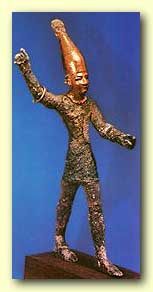
Figurine of Baal |

Figurine of Baal made of gold
|
Baal was a god for
fertility and weather. This carnival god has to be
prohibited, the patriarchs thought after the
collapse of North Reich of Israel in 7th century
B.C.
|
Relation to Egypt
has always two sides
-- Egypt always is a sheet anchor when
Canaan and the strip of Israel Palestine is affected by a
dry period [because Egypt has got more or less regular
harvests by the regular floods of Nile river]
-- but Egypt is also a permanent danger
because Egypt military strategists always are ready making
their campaigns to Mesopotamia [and for some periods this
was also realized] (p.84).
Egypt wants the occupation of a part of
"Fertile Crescent", the fertile part of territory in
Middle and Mid East.
At the same time the Empires of
Mesopotamia also want to dominate "Fertile Crescen" and
the aim allways is the occupation of the delta of Nile.
Therefore there are always military
campaigns passing Mid East.
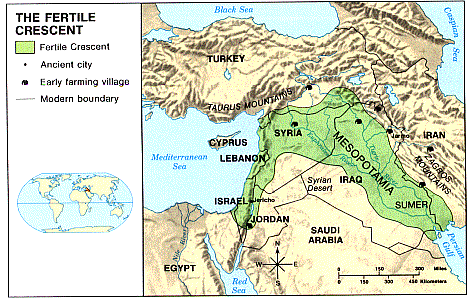 |
Map of "Fertile
Crescent"
The fertile territories go from Sinai to Persian
Gulf and are the aim of the Empires Egypt and
Mesopotamia. The military campaigns regularly
destroy the Middle East.
|
Place
names in the Bible and today
-- Gibeon = the ruins
near ed-Dshib
-- Bethel = the ruins near Betin
-- Silo = the ruins near Selun (p.27).
-- Kadesh-Barnea (oasis in Sinai) = En
el-Quderat, aside is the little spring En Qadis (p.77)
-- Debir (allegedly occupied during the
occupation) = Tell Bet Mirsim (p.94)
-- Betin (Arab village) = Bethel, is
said having been named Lus before the occupation (p.94).
Landscapes
in the Bible and today
The landscapes are the
same and the descriptions in the Bible correspond with the
real landscape of today (p.27).
[But according to the documents and
archeology the landscapes are the only thing which
corresponds. And Dead Sea does hardly exist any more today
(2010)].
["Christianity"
and Orthodox Jewry are refusing modern Bible research
In many circles of so
called "Christianity" Bible research is absolutely refused
until today. The pastors, Fathers and self-made preachers
in the house circles and on "missionary farms" etc. are
preaching Bible word for word until today, and are
preaching also the lies of Old Testament which are really
disproved].
Map with Israel, Judah, Ammon, Moab, Edom, Philistine, Araba.
Hill of ruins ("tell") of Megiddo


